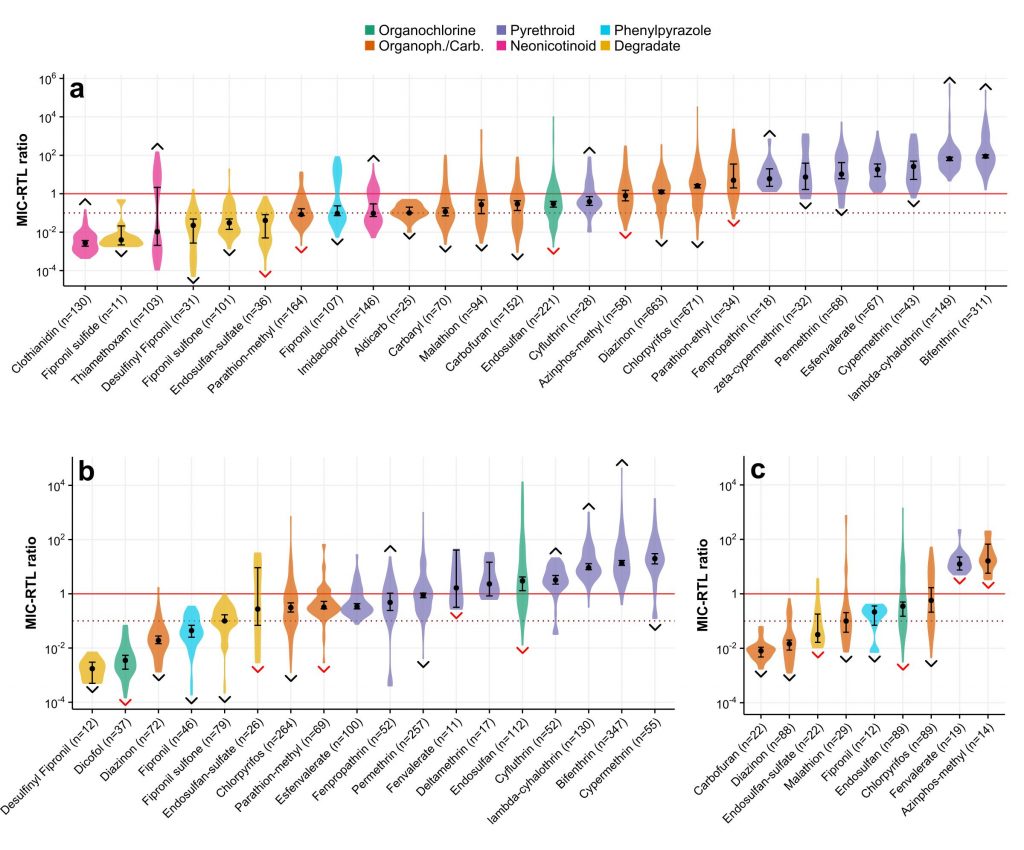In this post, Jakob Wolfram talks about their recently published paper “Meta-analysis of Insecticides in U.S. Surface Waters: Status and Future Implications”.
Insecticides are highly bioactive substances that can adversely affect aquatic ecosystem structure as well as functioning and represent an important pest control measure in the United States (U.S.). However due to their widespread use, non-target aquatic ecosystems are at risk of contamination at the national scale. Therefore, we analysed all available peer-reviewed literature (259 studies) detailing the occurrence of 32 insecticides in U.S. surface waters resulting from agricultural nonpoint source pollution and compared them with their regulatory threshold levels (RTLs).
We found that insecticides frequently exceeded their RTLs in both freshwaters and sediments (50% of measurements), and to a lesser degree in estuaries (31% of measurements). Those RTL exceedances were distributed throughout all 39 federal states with considerable agricultural production and were found in 629 different water bodies of varying size and hydrological characteristics. More so, roughly one quarter of insecticide concentrations exceeded their RTLs by a factor of 10 or more, highlighting the magnitude at which contamination events can occur. Additional analyses showed that smaller water bodies were at higher risk of experiencing threshold exceedances, which puts pivotal ecosystems at risk that serve as spawning grounds for endangered species and act as biodiversity refuges. Consequently, agricultural nonpoint source pollution by insecticides has national implications regarding U.S. freshwater integrity and also suggests that current regulatory practices should be critically reevaluated.

Furthermore, we analysed risks of individual substances in more detail and combined it with prospective risk estimations based on future use trends. These analyses revealed that in particular newer insecticide classes, i.e., pyrethroid and neonicotinoid insecticides, pose substantial risks to aquatic environments in the U.S. Following current shifts in the U.S. insecticide market, as many older compounds exit the market, pyrethroids and neonicotinoids have seen a meteoric rise in application, which further underlines their adverse potential on the national scale, now and in the future. Generally, we found that the insecticides responsible for threshold exceedances are changing over time, whereas the overall risk remained unchanged, which again hints that current regulatory practices do not adequately protect freshwater integrity and that adverse effects are likely continuing. In closing, nonpoint source insecticide pollution continues to be a wide-spread environmental issue in the U.S.
The paper was authored by Jakob Wolfram, Sebastian Stehle, Sascha Bub, Lara Petschick and Ralf Schulz, and was published in Environmental Science & Technology. Additionally, some interactive analyses can be accessed online at https://magic.eco/WebApp/ICC-US+v1.
The research was conducted within the MAGIC (Meta-Analysis of Global Impacts of Chemicals) group, which is working towards assessing chemical risks on the global scale. The working group offers Research Project Courses, Bachelor and Master theses. If you are interested, please contact them.
